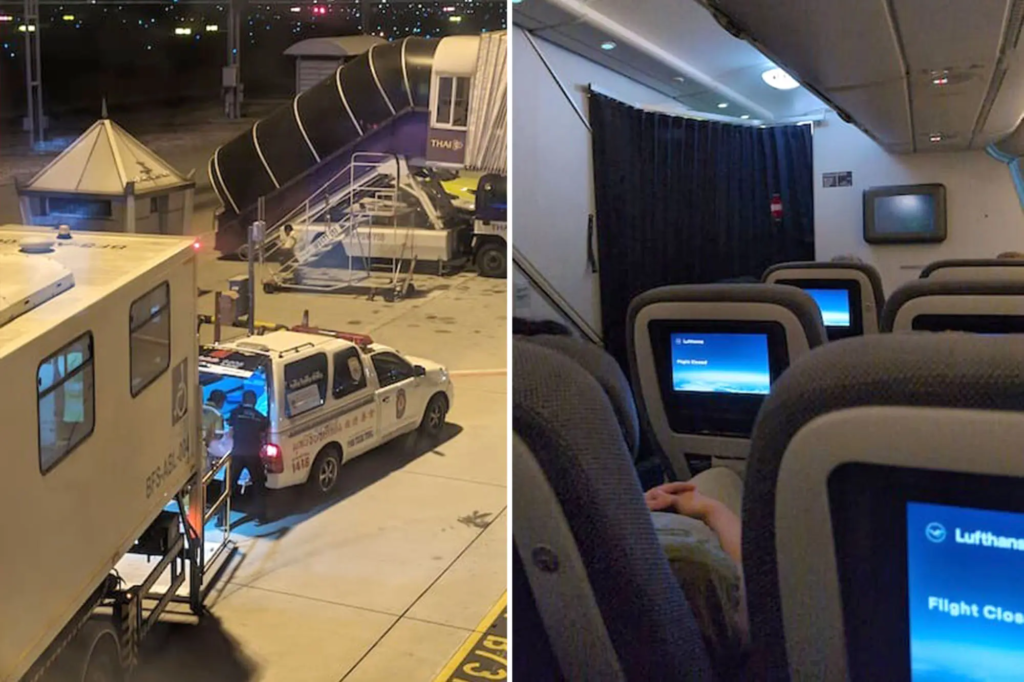Table of Contents
A tragic event occurred on a Lufthansa flight that has raised many eyebrows and concerns about in-flight safety and health emergencies. This incident involves a man who, during his flight, started coughing up an alarming amount of blood, leading to his unfortunate death. The gravity of the situation calls for a detailed exploration, not just of the incident itself, but also of the broader implications it holds for airline safety protocols, passenger health, and how such emergencies are managed in the air.
Imagine being thousands of feet in the air when a fellow passenger suddenly experiences a severe medical crisis. The confined space of an aircraft, the limited medical resources available, and the critical need for immediate action all come into sharp focus. This scenario became a stark reality on a Lufthansa flight, where a man’s life came to a tragic end after he coughed up ‘litres of blood’. The incident not only left passengers in shock but also prompted a closer look at how airlines prepare for and respond to such emergencies. Through this discussion, we aim to shed light on the critical aspects of this incident, from the immediate reactions to the implications for airline safety standards.
Background of the Tragic Lufthansa Flight Incident
On a seemingly routine flight, passengers and crew aboard a Lufthansa aircraft faced an unexpected and horrifying situation. The flight, which was en route from a major European city to another international destination, became the scene of a medical emergency when a man began experiencing severe health issues. Initial reports suggest that the man suddenly started coughing violently, an alarming situation that escalated quickly as he began to cough up significant amounts of blood. This incident serves as a stark reminder of the unpredictable nature of health emergencies and the challenges they pose in the confined, high-altitude environment of an aircraft.
The flight in question had departed on schedule, with passengers and crew unaware of the tragedy that would unfold mid-air. The man’s condition deteriorated rapidly, leaving everyone on board in a state of shock and concern. The crew’s response, the passengers’ reactions, and the ultimate outcome of this flight highlight the critical need for preparedness and swift action in the face of in-flight medical emergencies. It underscores the importance of understanding not just what happened, but also how it was handled and what can be learned from such distressing incidents.
Eyewitness Accounts of the Incident
Passengers who witnessed the incident described the scene as chaotic and frightening. Many were unprepared for the severity of the man’s condition, with some trying to offer help in any way they could. The cabin crew sprang into action, attempting to provide medical assistance and comfort to the man, while also trying to manage the reactions of other passengers. These eyewitness accounts provide a vivid picture of the human side of in-flight emergencies – the fear, the confusion, and the shared concern for a fellow human being in distress.
The response of those on board, from the crew to the passengers, paints a picture of a collective effort to address the situation, despite the limitations and challenges presented by the aircraft’s environment. The crew’s training in emergency response was put to the test, highlighting the importance of such preparation. Meanwhile, passengers’ accounts have contributed to a broader discussion on the adequacy of current safety protocols and the need for enhanced measures to handle such critical situations effectively.

The Medical Emergency Response on Board
In the critical moments following the onset of the man’s severe symptoms, the Lufthansa flight crew followed established protocols for in-flight medical emergencies. The aircraft was equipped with a medical kit, as is standard for commercial flights, which includes basic medical supplies and equipment designed to address a range of health issues. The crew also made an urgent call for any medical professionals on board to come forward, a common practice in such situations that can sometimes make a significant difference in the outcome.
However, despite these efforts, the man’s condition was beyond what could be managed with the resources available on the flight. This incident has sparked discussions about the adequacy of current in-flight medical kits and the training of airline staff to handle severe medical emergencies. It raises questions about what more can be done to prepare for and possibly prevent such tragic outcomes in the future, including the potential for more advanced medical equipment on board or enhanced training for flight crews in medical emergency response.
Understanding the Health Implications
The severe symptoms experienced by the man on this Lufthansa flight are highly unusual and indicative of a serious underlying health condition. Medical experts suggest that coughing up large quantities of blood, known medically as massive hemoptysis, can be caused by a range of pulmonary or cardiac conditions, including pulmonary embolism, severe infections, or major blood vessel ruptures. This incident highlights the importance of passengers being aware of their health status and potential risks before flying, as well as the need for airlines to be prepared for all types of medical emergencies.
The discussion around this tragic event also serves as a reminder of the limitations of medical care that can be provided in-flight. While airlines make efforts to equip planes with medical kits and train crew in basic response, there are inherent challenges in managing severe medical conditions at altitude. The situation underscores the critical importance of pre-flight health screenings for at-risk passengers and the ongoing debate about how to enhance in-flight medical capabilities to better handle such extreme emergencies.
Safety Protocols and Airline Responsibility
The tragedy on the Lufthansa flight brings into sharp focus the responsibility airlines have in ensuring the safety and well-being of their passengers. Airline safety protocols are not just about avoiding accidents; they also encompass the management of in-flight medical emergencies. The incident raises important questions about the extent of these responsibilities and the adequacy of current protocols to address severe health crises. Airlines are tasked with the complex challenge of balancing the practical limitations of in-flight medical care with the need to maximize passenger safety and respond effectively to emergencies.
In the wake of the incident, there is a heightened call for airlines to review and enhance their safety protocols. This includes not only the equipment and medical supplies on board but also the training provided to flight crews and the procedures for dealing with emergencies. The goal is to ensure that airlines are as prepared as possible for any situation that may arise, minimizing the risk of tragic outcomes and reinforcing the trust passengers place in air travel.
The Aftermath: Passenger Reactions and Airline Safety Debates
The reaction from passengers and the public to the incident on the Lufthansa flight has been one of shock and concern. For many, it has prompted a reevaluation of the perceived safety of air travel and the effectiveness of current measures to handle in-flight emergencies. The incident has sparked a broader debate about airline safety, focusing on the need for more comprehensive protocols and the potential for improvements in medical readiness on flights. This debate is crucial for the ongoing effort to make air travel as safe as possible for everyone.
Conclusion
The incident of the man dying on a Lufthansa flight after coughing up ‘litres of blood’ is a somber reminder of the unpredictability of health emergencies and the importance of being prepared for them. It has sparked important conversations about in-flight safety, the responsibilities of airlines, and the need for continuous improvement in emergency preparedness. As we move forward, it is crucial that these discussions lead to actionable steps that enhance the safety and well-being of all passengers in the air. The tragedy on the Lufthansa flight should serve as a catalyst for positive change, ensuring that air travel remains not just a marvel of modern life, but also a safe and caring environment for everyone.
FAQs on In-Flight Medical Emergencies
What do I do if I have a medical emergency on a flight? Inform the flight crew immediately. They are trained to assist with medical emergencies and can provide first aid and coordinate further actions.
Are flight attendants trained for medical emergencies? Yes, they receive training to handle basic medical emergencies, provide first aid, and use the onboard medical kit.
What medical equipment is on flights? Flights are equipped with an Emergency Medical Kit containing essential medications, supplies, and sometimes equipment for basic life support.
Can flights make emergency landings for medical reasons? Yes, if a passenger’s condition requires urgent care, the captain can divert the flight to the nearest airport.
How should I prepare for a flight with a health condition? Consult your doctor before flying, carry necessary medications, and inform the airline of your condition in advance.
What happens if someone dies on a flight? The crew follows specific protocols to handle the situation with respect and care, coordinating with authorities upon landing.
Are in-flight medical emergency protocols improving? Airlines regularly update their protocols based on new guidelines and feedback to enhance passenger safety and care.

